
 topics
topics
 download media
download media
 search
search
| 1500 - 1847 | 1848 - 1919 | 1920 - 1959 | 1960 - 1999 | 2000 - 2020 |
Manifest Destiny 1848 - 1919





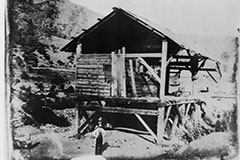

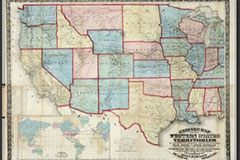

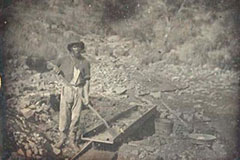

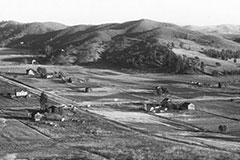

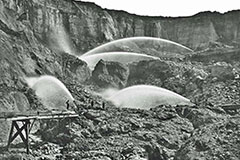

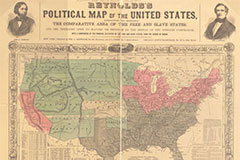

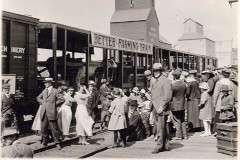

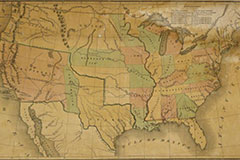

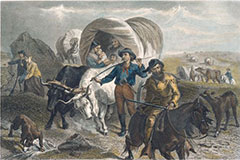

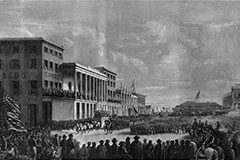

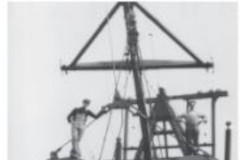

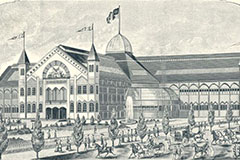

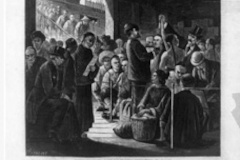

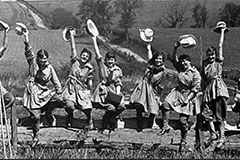


What would you like to find?

Downloadable Media: Manifest Destiny
Imagery



















James W. Marshall discovered gold at Sutter's Mill near Coloma, California on January 24, 1848.

John Sutter, 1803-1880
John Sutter was a Swiss immigrant who arrived in California in 1839. Sutter planned to establish a colony in the Central Valley, convincing the Spanish Governor to grant him 48,000 acres of land. Sutter named this property New Helvetia (“New Switzerland”). Most of this land was valuable agricultural property, supporting a large cattle herd, wheat, apple trees, peach trees, and trees of other types.
The California Gold Rush began after the discovery of gold on Sutter’s property, at Sutter’s Mill. The discovery of gold led to Sutter’s decline in fortune, as 49ers invaded the property and caused damage and loss. In addition, Sutter could not find any agricultural laborers, as farm work was abandoned in the pursuit of finding gold.
Questions
What was John Sutter's path to the U.S.?
Where did he travel to first?
Cendrars, Blaise. Gold Being the Marvellous History of General John Augustus Sutter. New York: M. Kesend Pub, 1984.
The United States acquired more than 500,000 square miles of Mexican territory extending westward from the Rio Grande to the Pacific Ocean.

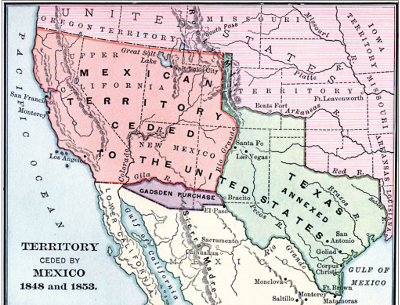
Treaty of Guadalupe Hidalgo, 1848
The Treaty of Guadalupe Hidalgo, officially ending the Mexican-American War (1846-48), was signed on February 2, 1848. The treaty added approximately 525,000 square miles to the United States, including lands that make up parts of present-day Arizona, California, Colorado, Nevada, New Mexico, Utah, and Wyoming. In exchange for the land, and as a form of reparations for damages, the U.S. paid Mexico $15 million. Neither the U.S. nor Mexico was aware that gold had been discovered just nine days prior to the signing of the treaty.
See the full transcript of the treaty here.
Questions
Why would Mexico cede such a large amount of territory to the U.S.?
Would the price have been different if either country had know about the discovery of gold in California?
history.com
Transportation advances, especially the development of a transcontinental railroad, made moving people, goods, and food faster and more cost effective.

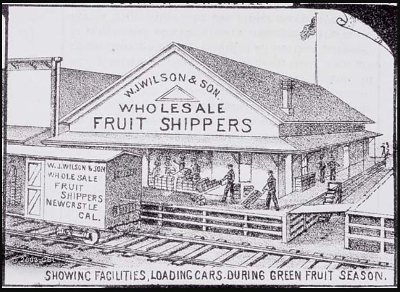
Newcastle, CA, 1870s
The ongoing development of railroad lines and routes allowed various California regions to become agricultural centers. With an increasing range of shipping came an increasing demand, and associated production, for goods that would be grown in one region and shipped across the country to other areas. For example, Newcastle, which at the time was well-known as a center of gold country, became better known for its variety and abundance of orchard fruit and nuts. Newcastle Fruit Growers Shipping and Preserving Association, formed in the late 1870s, is an example of just one of many associations and companies formed to support farmers as production increased.
To learn more about how the Transcontinental Railroad transformed California, visit Union Pacific’s The Great Race to Promontory website celebrating the 150th Anniversary of Driving the Golden Spike.
Questions
How were other California towns directly impacted by the building of the railroad?
Union Pacific Heritage

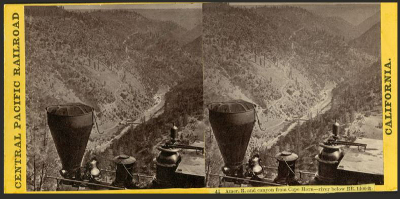
Construction on Transcontinental Railroad Begins, 1862
On July 1, 1862, President Abraham Lincoln signed the Pacific Railway Act. The Central Pacific Railroad of California, chartered in 1861, was authorized to build a line east from Sacramento. At the same time, the Act chartered the Union Pacific Railroad Company to build west from the Missouri River. The legislation granted each railroad 6,400 acres and up to $48,000 in government bonds for each mile completed. And so, “The Great Race” began.
The ongoing Civil War, which had resulted in a labor shortage and economic issues, delayed the start of the railroad project. As the fighting continued, it became increasingly important to lay the tracks in order to transport men, food, and other supplies across the country.
Follow this link to learn more about railroads in the U.S. and the Transcontinental Railroad.
Questions
What were the motivations behind the construction of the Transcontinental Railroad?
Why would President Lincoln make this a priority during his presidency?
Union Pacific Heritage

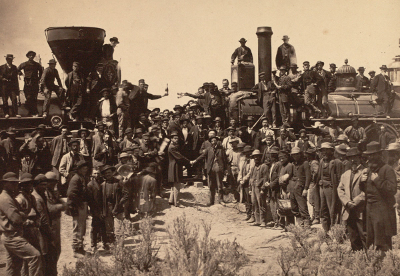
Transcontinental Railroad Completed, 1869
The Transcontinental Railroad was completed with the ceremonial Golden Spike in Promontory, Utah on May 10, 1869. This completion connected Sacramento, and therefore the rest of California, to the Midwest, where people and goods could continue traveling on the existing railroads reaching the eastern states.
Along with increased trade opportunities, the railroads allowed settlement in areas that had previously been secluded and undesirable for settlers. By 1872, there were 150 miles of railroad into the San Joaquin Valley, prime farming land that had previously been ignored in favor of locations closer to towns. There were 50 miles of track in the Sacramento Valley and an additional 30 miles of track in the Salinas Valley, opening these areas up to settlers interested in farming. All three regions became important agricultural regions and continue to produce large amounts of agricultural products now.
To learn more about how the Transcontinental Railroad transformed California, visit Union Pacific’s The Great Race to Promontory website celebrating the 150th Anniversary of Driving the Golden Spike.
Questions
How did the railroad boost agricultural production?
What were other technological advances that aided the agricultural boom?
Union Pacific Heritage Timeline

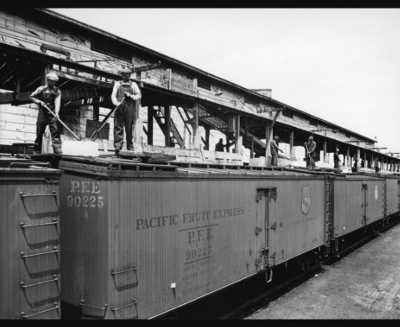
Pacific Fruit Express, 1906
The Pacific Fruit Express Company (PFE) was created as a joint venture of Union Pacific Railroad and Southern Pacific Railroad in 1906, and the fleet began operating in 1907. Company owner E.H. Harriman originally ordered 6,000 refrigerator cars, known as “reefers,” which were cooled by ice stored at each end of the car. The PFE shipped vegetables, fruits, and other perishable items from the Western U.S., mainly California at the outset, to markets in the northern and eastern states. By 1921, P.F.E. grew to almost 20,000 rail cars.
For more details on the original refrigerator cars, check out the Pacific Southwest Railway Museum Association’s collection details, including this page detailing a train car built in Roseville, CA in 1953.
Questions
How did the PFE expand the availability of fresh produce?
In which ways would the PFE have contributed to the increased production of fruit by California growers?
Union Pacific Heritage Timeline ; Pacific Southwest Railway Museum Association

Roseville: The Ice Capital of the World, 1910-1972
Pacific Fruit Express, established by both Union Pacific and Southern Pacific, built the world’s largest artificial ice plant in 1909. The ice plant would produce up to 300 tons of ice per day; this ice would be used to refrigerate railroad cars that carried produce across the U.S. to the Eastern states. Railroad cars would arrive empty in Roseville, were loaded with ice, then would travel to key agricultural regions like the Central Valley to be loaded with fruits and vegetables before traveling across the country.
The process:
-
Ice cans were filled with water and loaded into the floor of the plant
-
Brine ran through pipes in the floor, freezing the water in 24 hours.
-
A crane would lift the ice cans up and tip them out, and workers would break them into smaller pieces.
-
Refrigerator cars would be hooked up to a machine that would blow cold air through the car for hours, lowering the temperature, before ice was loaded into the bunkers of the car.
Technology advanced, and the need for massive amounts of ice in order to cool refrigerated cars declined. The ice plant ceased operations in 1972, and the plant would be destroyed in 1974.
Questions
What led to the decline of the ice industry?
Ansel Oliver, "A chip off the history block," The Press-Tribune (2006)

Overland Transportation, 1850-1900
Although California became a state in 1850, it was on the other side of the continent from the majority of the U.S. The Midwest was not developed, and traveling across the country took months. Stagecoaches carrying mail began crossing the United States in 1858, followed by the Pony Express, a horse and rider mail service, in 1860. Congress tried introducing camel caravans to cross the deserts of the Southwestern states in 1855 to carry goods from New Mexico to California. The camels did well, but the government retired the camels in the early 1860s and auctioned them off to private buyers.
Questions
What motivated Congress to try using camels to transport mail and goods across the Southwest?
Why do you think the camels were a short-lived experiment and not a continued method of transporting goods?
C. Heller, "Whatever Happened to the Wild Camels of the American West?" Smithsonian Magazine, 2015
The population of California skyrocketed after the discovery of gold in California.

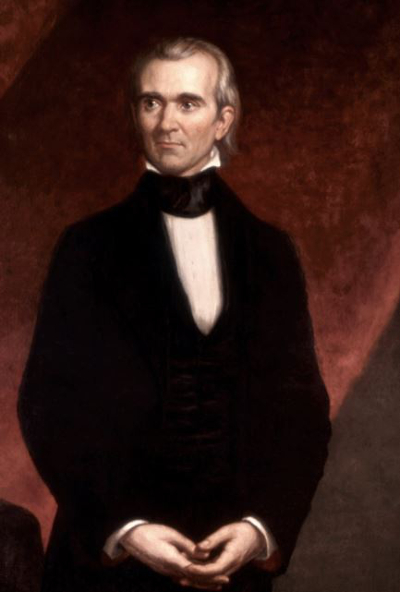
President Polk Announces Gold, 1848
The Military Governor of California, Colonel Richard B. Mason, wrote a report confirming the presence and amount of gold that had been discovered, and sent a tin of gold to Washington, D.C., as proof.
On December 5, 1848, President James K. Polk gave his State of the Union Address and confirmed that the reports of gold in California were true. He stated, “The accounts of an abundance of gold are of such an extraordinary character as would scarcely command belief were they not corroborated by the authentic reports of officers in the public service.” This announcement would feed the Gold Rush as the first official confirmation by a government agency or official that there was a large amount of gold to be found in California.
To read the full transcript of President Polk’s speech, see the December 5, 1848: Fourth Annual Message to Congress
Questions
What impact did President Polk's announcement have on the population of California?
How did the announcement affect the demand for food and impact agricultural production?
President James K. Polk, Fourth Annual Message to Congress, December 5, 1848

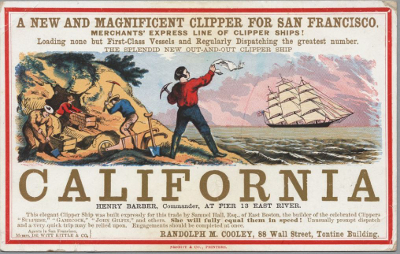
Traveling to California, 1849-1860
Traveling to California was not a simple process. At the onset of the Gold Rush in 1849, there were three ways to get to California for east coast Americans.
Option 1: Sail around Cape Horn, a distance of 18,000 nautical miles, on a trip that took between 5 and 8 months. This trip could be interrupted by dangerous storms and a host of other issues.
Option 2: Sail to Central America, cutting the amount of time spent on a ship, then cross Central America in Panama before boarding another ship up the coast to San Francisco. This option could be more cost effective but it was dangerous sea travel combined with the risk of malaria and yellow fever during the crossing at Panama.
Option 3: The overland route from the East Coast of the country to the West Coast covered 2,000 miles, took 3-4 months, and covered extremely difficult terrain. Sickness, accidents, and conflicts on the road complicated the trip.
People had to eat on all of these trips. The majority of sea travel methods were run by shipping companies that set up routes and organized food and supplies for the number of people and amount of time spent on the ship, creating some demand for mass production near ports but did not affect California’s agriculture production.
Land travel required more individual planning, and most westward travelers brought supplies for the months on the road. However, land travel also allowed people to trade and purchase goods from farmers and Native Americans across the Midwest and Western regions.
In the new U.S. territories in the West, most of the land was used for grazing livestock and small family farms rather than production agriculture. The average American had little concept of what life in the Western half of U.S. territory was like, and would be surprised to see all of the open, available land in California on the way to the gold mines. Many of these travelers would return to the wide-open fields as the gold rush declined and begin transforming the open landscape into production agriculture land.
Questions
What did the large numbers of pioneers and 49ers likely encounter as they crossed the U.S. by land?
What were the dangers?
Why would someone choose to travel by land instead of by boat?
Rawls, J. and Orsi, R. (1999). A Golden State: Mining and Economic Development in Gold Rush California. University of California Press.

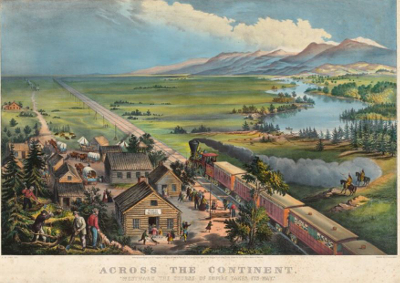
"Go West!"
The population of California in March 1848, two months after the discovery of gold at Sutter’s Creek, was approximately 700 Americans, 6,500 Californios (people of Mexican or Spanish descent residing in California), and 150,000 Native Americans.*
By December of 1848, the number of Americans had risen to 20,000. In 1849, the non-native population of California numbered about 100,000. And by the end of 1860, the state population of California was 380,000.
This rise in population also created a rise in the number of gold-mining towns across the state, which had shops and saloons that catered to the miners. To feed these miners, shop owners bought produce and crops from local farmers, who increased production to keep up with the increased demand for food.
*This number is an estimate; it is difficult to determine the exact number of Native American residents in California.
Questions
Why were so many Americans willing to leave the East Coast or the South in favor of the chance of getting rich in California?
How did most people earn a living on the East Coast?
What about in the South?
Quote: Horace Greeley to R. L. Sanderson, November 15, 1871 (Gilder Lehrman Collection) ; population information: history.com
The discovery of gold and the subsequent cycle of boom and bust in California fueled the U.S. economy and drove the need for development of the state. Cities, farms, and ranches began to appear all over California to supply miners with supplies, places to live, and food.

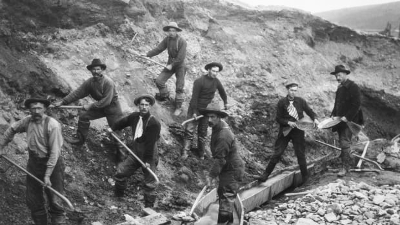
Miners Make Millions, 1849-1852
Between 1849 and 1852, the first four years of the Gold Rush, the amount of money dug out of the ground was incredible! $10 million in 1849 is equivalent in purchasing power to approximately $347 million today.
In 1849, miners produced $10 million in gold.
In 1850, miners produced $41 million in gold.
In 1851, miners produced $75 million in gold.
In 1852, miners produced $81 million in gold.
After 1852, there was a gradual decline in the amount and quantity of gold found, until 1857, when the amount leveled off and approximately $45 million in gold would be found yearly.
As the amount of gold collected by miners declined, Californians realized that the gold industry could not sustain the state’s economy forever. In 1854, state legislators turned their attention to the second biggest industry, agriculture.
Questions
How did miners spend their money?
What did the influx of cash mean for California's development?
pbs.org

Californias First Migrant Labor Force, 1850-1890
Chinese immigrants became the first migrant labor force in California. Following the Gold Rush and the construction of the Transcontinental Railroad, many Chinese immigrants settled in small towns around the state. These Chinese immigrants brought traditional techniques and created new methods to grow crops in California, and would develop new varieties of fruits and rice through crossbreeding. Chinese immigrants also grew vegetables on small plots of land rented or leased from American citizens, and in some cases would join together to operate larger businesses as a group. In the 1880s, Chinese immigrants and first-generation Chinese Amerians grew of California’s vegetable crops.
Questions
What was the draw for Chinese immigrants to come to the U.S.?
California Museum
In 1859, California sought statehood. However, this attempt to join the U.S. led to a heated debate in Congress over slavery, and whether California should be a free state or a slave state. On September 9, 1850, the state officially joined the Union as a free state, prohibiting slavery, under the Compromise of 1850.
By 1853, many disillusioned miners that had failed to strike it rich returned to farming. Instead of returning home, they stayed put in California. After the mid-1850s, California’s agricultural production skyrocketed.

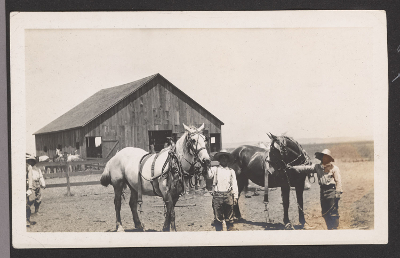
Farm Labor in California, 1850-1919
Migrant workers from Mexico, Native Americans, Japanese immigrants, and Chinese immigrants (many of whom had originally been brought to the U.S. to work on the Transcontinental Railroad) were hired to work in fields as harvesters and day laborers to keep agricultural production moving during the Gold Rush and the Civil War. These workers formed tight-knit groups, banding together to negotiate better pay and working conditions.
Questions
Why would Native Americans work as farm laborers?
What were the dangers of farm labor in the mid-1800s?
Jelinek, L. "'Property of Every Kind': Ranching and Farming During the Gold-Rush Era." California History (1998) vol. 77 no. 4

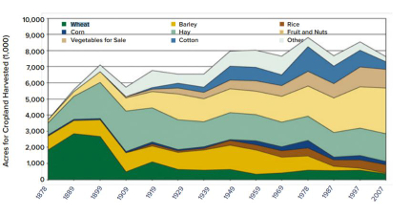
Wheat - the Gold of the 1860s
Wheat became the primary grain on the West Coast, as evidenced by the huge increase in production between 1860, when just 6 million bushels of wheat were produced, and 1870, when over 16 million bushels of wheat came from California farmers. Over 70% of that wheat came from the Sacramento and San Joaquin Valleys, where many of the failed miners had settled and pursued farming.
Wheat surpluses were shipped to Great Britain, Australia, New York, and even China during the early 1860s. The Southern states, whose agriculture industry had been decimated by the war, both in terms of labor and property damage, were another market for wheat exports.
Questions
How much wheat does California produce today?
Which states are the national leaders in wheat production?
Why has much of the nation's wheat production slowly shifted away from California over time?
Jelinek, L. "'Property of Every Kind': Ranching and Farming During the Gold-Rush Era." California History (1998) vol. 77 no. 4

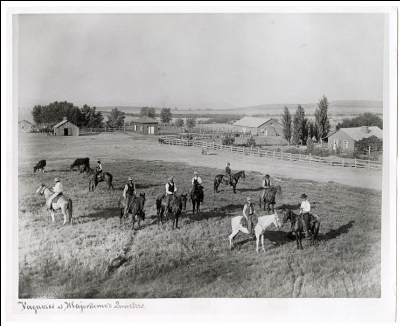
Cattle Industry Fluctuates, 1855-1880
The rising population of California presented a new market for cattle rancheros (Mexican ranchers), as miners in need of food purchased beef in large amounts. Rancheros, enjoying their good fortune, began purchasing and importing large numbers of cattle to the Gold Rush regions. Competitors in Texas, the Midwest, and Mexico followed suit and by 1855 up to 40,000 cattle were driven to California annually.
Unfortunately, a severe drought in 1856 hit the cattle industry especially hard, and many rancheros lost their herds, their land, and sometimes their homes. The winter of 1861-62 had heavy rainfall, and a flood in the Central Valley led to nearly 200,000 head of cattle drowning. Then, a drought in 1862-64 led to large numbers of cattle dying from dehydration and starvation.
This combination of events drove the number of cattle down sharply, and rancheros suffered financially. By the 1870s, many rancheros had lost everything and became farm workers and day laborers. Wealthy Americans and immigrants bought up the land and homes left behind by destitute rancheros.
These wealthy landowners used their good fortune to import better quality cattle, often of meatier and stronger breeding stock, and to introduce modern feeding practices and breeding programs. The practice of fencing in grazing lands also helped increase profits and protect cattle herds. These practices helped stabilize the beef market in California during the late 1860s through the 1870s.
Questions
What other agricultural developments could have contributed to the stabilization of the cattle industry in California?
Jelinek, L. "'Property of Every Kind': Ranching and Farming During the Gold-Rush Era." California History (1998) vol. 77 no. 4

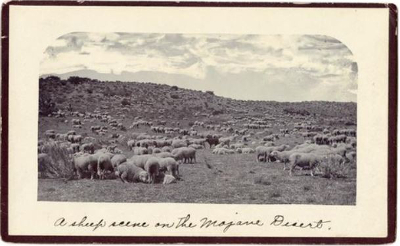
Popularity of Sheep Increases, 1850-1870
In 1849, the population of sheep, originally imported by the Spanish settlers and maintained by Mexican herders, hovered around 20,000 head. Mutton became a staple of miners’ diets during the Gold Rush as an alternative option to beef and the number of sheep shot up towards one million by 1860.
The increased demand for wool and meat combined with better breeding stock created a successful sheep industry in the state. Despite severe drought between 1862 and 1864, the number of sheep in California continued to rise and sat at about 2.75 million head in 1870. In addition to continuing the original breeds brought by the Spanish, new breeds including French and Spanish Merinos, Cotswolds, Leicesters, Southdowns, and even Australian Sheep were introduced in the late nineteenth century.
However, during the 1870s the sheep market declined due to a combination of increasing land values and blocked migration routes to pasture lands. Increasing land values meant limited grazing options, a decrease in available natural water sources, and the growing population and railroad created blockages for migratory herds.
Questions
Why would ranchers begin raising sheep instead of cattle?
How were sheep more cost effective?
Jelinek, L. "'Property of Every Kind': Ranching and Farming During the Gold-Rush Era." California History (1998) vol. 77 no. 4

Dairy Industry Takes Off, 1850-1880
Originally, milk production was done by individual families to suit their needs during the Gold Rush. Over time, small dairy herds appeared in the Sierra foothills to meet the need for milk and butter in mining towns. Larger dairy herds, close to populated areas, ensured that milk could be transported without spoiling, and with the introduction of railroads and refrigerated rail cars, milk, cheese, and butter could be transported further. California’s climate and the large amounts of available pasture created a large dairy industry.
In 1850, 705 pounds of butter and 150 pounds of cheese were produced in California.
By 1880, 16 million pounds of butter and 3.7 million pounds of cheese were produced by California dairies.
Questions
What advancements made the growth of the dairy industry possible?
How did the development of the railroad encourage the increasing sizes of dairy herds?
California State Parks, "Guide to the California Dairy Industry History Collection" Published 2005

Chinese Immigrants Settle in Locke, CA, 1915
The Locke Historic District, or the town of Locke, California, is the largest, most distinct example of a rural agricultural Chinese American community in the U.S. The town was built in 1915 by Chinese immigrants from Guangdong Province, China. During the 19th century, Asian immigration to the U.S. took off due to a combination of factors including the California Gold Rush and the Taiping Rebellion in Southern China. Chinese immigrants became the main source of labor for the Central Pacific Railroad’s piece of the Transcontinental Railroad.
After completion of the railroad in 1869, Chinese laborers were hired to work on levee projects in the Sacramento-San Joaquin River Delta area. Eventually, over 500,000 acres of swamp land would be reclaimed and become valuable farmland. Many of these laborers remained in the area and worked as farm laborers, settling in small towns along the river including Walnut Grove, Isleton, Rio Vista, and Courtland. After a fire destroyed the Chinese community in Walnut Grove, a group of Chinese businessmen chose to move to a small piece of land about a mile north of Walnut Grove. To circumvent the 1913 Alien Land Law, preventing non-US citizens from owning land, the land formally remained George Locke’s possession, while the buildings and businesses were legally owned by the Chinese businessmen.
Locke experienced a cycle of ups and downs throughout the twentieth century, becoming a thriving area during Prohibition and suffering an economic decline during the Great Depression. WWII provided a brief boom, but younger Chinese Americans began to move out of the small town and into cities, looking for better opportunities, and taking income with them. At the end of the twentieth century, Locke was designated a National Historic Landmark in order to preserve its historical value.
Questions
Why would Chinese immigrants choose to form their own community rather than rebuilding in Walnut Grove?
National Park Service
Scientists, government agencies, and agriculturalists worked to create more productive farmland in California using different techniques. Specifically in the nineteenth century, the state worked to expand areas of agricultural production by reclaiming marshlands and building dams and levies.

Early Irrigation, 1902-1910
The Newlands Reclamation Act, passed in 1902, was a federal law that funded irrigation projects for arid land in the Western U.S. The act set aside money from the sale of public lands for the construction, and maintenance, of irrigation projects. Irrigated land could then be sold, and money from that sale would be set aside and used for future irrigation projects.
California’s East Park Dam, near Orland, was built by the U.S. Bureau of Reclamation using these funds and completed in 1910. Eventually, the Orland Project would include two main dams to store water, two diversion dams, and more than 150 miles of connections and canals. Availability of water transformed the region by expanding agriculture production and bringing more residents to the area.
U.S. Bureau of Reclamation

Tule Horseshoe, 1880s
During the late 1800s, land surrounding the Sacramento River was reclaimed from marshland and developed into farmland. However, the soft soil of the California Delta was difficult for horses to work in. Horses would get stuck in the soil and panic, causing injury to themselves or their drivers. To solve this problem, Chinese laborers developed an oversized horseshoe made of wooden planks. By distributing the horses’ weight across a larger surface area, it was possible to avoid sinking into the soil and the associated dangers. This design would be modified to a more practical metal design.
Questions
What was the original issue with using horses in the Delta regions?
California Museum

Reclamation of Marshlands, 1860-1880
On September 28, 1850, Congress passed the Arkansas Act, giving all public land states, including California, all of the unsold swamp and overflow lands within their borders. A series of land acts passed by the state of California attempted to prompt the sale of these lands to private buyers, but by 1861 it was clear that the lands—as they were—would not sell. In 1861, California legislature passed “An Act to Provide for the Reclamation and Segregation of Swamp and Overflowed, and Salt Marsh and Tide Lands, donated to the State of California by an Act of Congress.” The state assumed responsibility for reclamation of swamp lands, and began building levees. Between 1860 and 1880, 88,000 acres of land were reclaimed and repurposed from marshlands to farmland.
Questions
What methods were used to reclaim land in the Delta?
What machine was invented to help with this process?
Source: Richard H. Peterson, The Failure to Reclaim: California State Swamp Land Policy and the Sacramento Valley, 1850-1866, Southern California Quarterly Vol. 56, No. 1, 1974
Water delivered to the mining site through various means would be pumped through a nozzle at high pressures onto a rock face, usually a cliff. This water would erode the rock and wash away tons of boulders, gravel, and dirt. Hopefully, gold would be revealed in this process, as miners would then pan through the products and search for small pieces of the precious metal. This process was first used in 1853 by inventor Edward Matteson. Hydraulic mining allowed more widespread gold mining as rock could be more easily eroded. This expansion of the mining industry pushed agriculture into these new mining areas and contributed to the growth of towns across the state.
David Beesley, Beyond Gilbert: Environmental History and Hydraulic Mining in the Sierra Nevada, Mining History Journal, 2000.

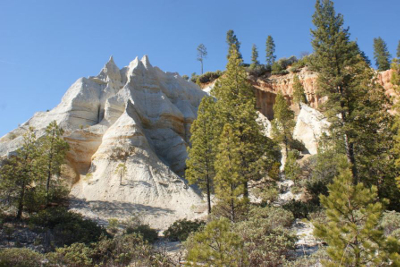
Environmental Impacts of Hydraulic Mining, 1853-1884
Hydraulic mining processes began in 1853 and were outlawed in 1884 after a legal battle between mining companies and farmers. Hydraulic mining could be linked to flooding and damage to water sources, thereby negatively affecting the increasingly valuable agriculture industry; the U.S. District Court in San Francisco banned hydraulic mining.
Questions
When was hydraulic mining outlawed?
Who benefitted most from hydraulic mining?
Who benefitted most from the outlawing of hydraulic mining?
David Beesley, "Beyond Gilbert: Environmental History and Hydraulic Mining in the Sierra Nevada," Mining History Journal, 2000.

Early Conservationists, 1901-1913
California’s growing population meant a greater demand on natural resources. The growing city of San Francisco proposed building a dam on the Tuolumne River in the Hetch Hetchy Valley to provide a steady water supply. The Hetch Hetchy Valley was within Yosemite National Park and protected by the federal government, leaving it up to Congress to decide the valley’s fate.
This disagreement highlighted the tension between conservationists, who felt that the environment should be used in a conscientious manner to benefit society, and preservationists, who believed that nature should be protected and safe from human interference. Hundreds of concerned parties across the United States sent petitions to Congress expressing opinions about the proper use of National Park land. In the end Congress passed legislation to allow the creation of the dam in the Valley. President Woodrow Wilson signed the bill into law on December 19, 1913. The reservoir continues to provide water and power to San Francisco today.
This conflict raised public awareness of preserving the natural resources and beauty of the U.S. The National Park Service would be established in 1916, three years after the decision was made regarding the Hetch Hetchy Valley.
Questions
If you were asked whether the Hetch Hetchy Valley should be restored (and the dam destroyed) in order to restore the Valley's natural resources, what would you say?
What would be your reasoning?
National Archives "Hetch Hetchy Environmental Debates" ; Kurt Snibbe, "How California became the first environmental battleground," The Orange County Register, April 21, 2017
In 1854, the state legislature created the California State Agricultural Society. This society was responsible for establishing experimental farms, holding state fairs and stock shows, and seeking improvements in farming and ranching practices.
Carson Hendricks (2010). California State Fair. Arcadia Publishing.

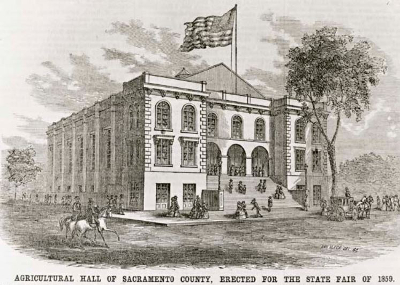
California State Fair Begins, 1854
The California State Fair began in 1854 in San Francisco. The Fair moved through various cities before landing permanently in Sacramento, the state’s capitol, in 1860. The original State Fair included exhibits of the state’s fruits, vegetables, flowers, grains, and livestock animals, much like today’s county and state fairs. In addition, farmers and laypeople from across the state could come to the State Fair to enjoy the fair entertainment and learn about new farm machinery and technological advances.
Questions
How did the state fair aid farmers?
What did the State Fair mean for non-farmers and their awareness of agriculture?
Carson Hendricks (2010). California State Fair. Arcadia Publishing.
The American Civil War was fought between the Northern and Pacific States, known as the Union, and 13 southern states that voted to secede from the United States and formed the Confederate States of America. The cause of the Civil War centered around the issue of slavery, as southern states continued to practice slavery while the majority of northern states outlawed the practice. Southerners grew increasingly concerned that the slave-holding states would be outnumbered by free states and would lose power in Congress. When Abraham Lincoln won the 1860 Presidential election, this concern seemed to have been proven correct.
War broke out in 1861 and would continue for four years. While the North primarily focused on industrial production, the South had been the main source of crops and agriculture in the U.S. As men in the North and South joined the military, both industries would face severe decline. The South especially saw major economic losses as farm workers left their property and slaves abandoned their owners, running North to freedom. The loss of this farmland would be somewhat offset by the increasing agricultural production from the Pacific states, including California. In addition, California would provide valuable support for the Union Army economically, as the gold mines and wealthy Union supporters kept the Union war effort well-funded. California would make massive contributions to the U.S. Sanitary Commission, the organization that provided medical treatment of Union casualties.

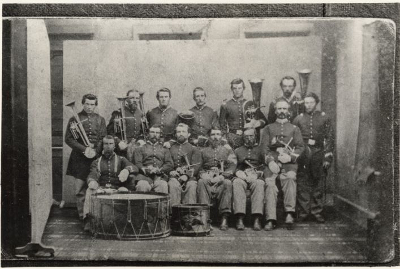
California's War Efforts 1860-1865
Approximately 17,000 Californians joined the Union Army. While many of these men would not see official Civil War battles, some would travel across the country to join the fight.
The California 100, the nickname given to the 100 Californian cavalrymen, traveled to Massachusetts to join the 2nd Massachusetts Cavalry. The California 100 was later joined by three more companies of Californians and formed what would be known as the California Battalion. The California Battalion spent the first year of their service in continual conflict with John Mosby’s guerilla battalion. In 1864, the California Battalion joined Phil Sheridan’s Army of the Shenandoah and was active throughout the Shenandoah Valley campaign; taking part in the largest cavalry charge of the Civil War at the Third Battle of Winchester and as part of the Union counterattack at the Battle of Cedar Creek.
The large number of men that joined the military created a need for additional agricultural laborers. The lack of available U.S. citizens meant that migrant laborers and immigrant laborers would become the main source of farm work moving forward. Beyond the worker shortage created by the Civil War, the increasing demand for food production meant that more workers were required. Migrant workers from Mexico, Native Americans, Japanese immigrants, and Chinese immigrants (many of whom had originally been brought to the U.S. to work on the Transcontinental Railroad) were hired to work in fields as harvesters and day laborers in order to keep agricultural production moving.
Questions
Why is California often left out of discussions about the Civil War?
Were there secessionists in California?
California State Military History and Museums Program - California and the Civil War ; CA Department of Parks and Recreation
California, and its potential for success during the Gold Rush and railroad building processes, had drawn in huge numbers of immigrants from other countries in addition to the migrants from the East Coast states. Immigrants faced significant challenges, including legal restrictions and discrimination.

California Alien Land Law of 1913
The California Alien Land Law of 1913 prevented Asian immigrants from owning agricultural land or possessing long-term leases over it. Leases lasting less than 3 years were allowed. The intention was to prevent immigrant farmers in California from owning land and securing political control or power over any certain area. In addition, lawmakers hoped to discourage continuing immigration from Asian countries and to make life more difficult for the immigrants already living in California.
Questions
How did 'aliens' circumvent the Alien Land Law?
What were the loopholes in the law?
A More Perfect Union, American History Smithsonian Institute

Chinese Exclusion Acts, 1880s
During the 1880s, Congress passed a series of laws attempting to restrict Chinese immigration. Many Americans, especially on the West Coast where Chinese immigrants settled after the building of the Transcontinental Railroad and the Gold Rush, attributed low pay rates and economic issues to the presence of Chinese workers. As the numbers of Chinese laborers increased, so did the strength of anti-Chinese sentiment among other workers in the American economy.
-
1882: The Chinese Exclusion Act suspended immigration of Chinese laborers for 10 years. Every Chinese person traveling into or out of the U.S. was required to carry a certificate identifying their status as a laborer, student, diplomat, or merchant.
-
1888: The Scott Act made reentry to the U.S. after a visit to China impossible, even for long-term legal residents.
-
1892: The Geary Act renewed the original Chinese Exclusion Act for an additional 10 years.
Despite these restrictions on immigration and anti-Chinese sentiment across the U.S., Chinese immigrants—and later first and second generation Chinese-Americans—would make a lasting impact on California’s agriculture industry.
Questions
What were the main motivations for the Chinese Exclusion Acts?
U.S. Department of State Office of the Historian
Demonstration trains were operated by railroad companies in cooperation with state agricultural agencies, agriculture colleges, and the USDA. Demonstration trains aided the railroad companies by providing income, while rural residents benefitted from the advice of agricultural experts.

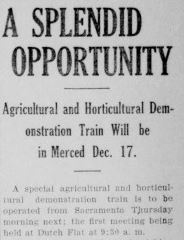
Agricultural Demonstration Trains, 1908-1914 (approx.)
Beginning in 1908, the University of California and the Southern Pacific Railroad began operating an Agricultural and Horticultural Demonstration Train. This train traveled across the U.S., stopping in cities and towns to demonstrate new and innovative methods of farming and cultivating agricultural products—a “university on wheels.”
Experts believed that, although techniques and methods that improved production and efficiency were publicized and spread via reports, it would be easier for rural farmers to put them into practice by seeing them in person. Topics covered by the demonstration train included: field crops, soils, fertilizers, veterinary science, the dairy industry, entomology, plant diseases, poultry, home economics, and honey production; other topics would be covered depending on the availability of staff and experts traveling on the train.
Though the California train was not the first of its kind, it was the most developed and comprehensive effort. Approximately 17-24 experts from the University of California College of Agriculture participated in each trip, answering questions and providing farmers with valuable advice.
Questions
What methods and approaches should be used in modern times to communicate and demonstrate new technology to the agricultural community?
If Agricultural Demonstration Trains were revived and used today, what topics should be covered?
Warren T. Clarke, "Farmers' Institutes and University Extension in Agriculture," University of California College of Agriculture, 1910 ; Pacific Rural Press vol.81, no. 2 1911
WWI began in 1914. Although America remained neutral until 1917, the U.S. supported both the Central Powers and the Allied Powers before joining the fight (on the side of Allied Powers) by declaring war against Germany.

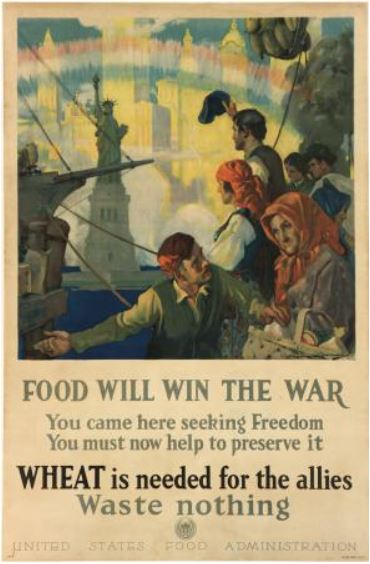
Executive Order 2679-A, 1917
On August 10, 1917, President Wilson issued an executive order that created the U.S. Food Administration. According to the executive order, the U.S. Food Administration was to:
a. Assure the supply, distribution, and conservation of food during the war;
b. Facilitate transportation of food and prevent monopolies and hoarding; and
c. Maintain governmental power over foods by using voluntary agreements and a licensing system.
Herbert Hoover, as head of the U.S. Food Administration, created an advertising campaign called “Food Will Win the War,” encouraging American citizens to support the war effort through eating specific crops while preserving others for troops, avoiding waste, and creating ‘victory’ gardens to sustain communities.
Learn more about Executive Order 2679-A and the U.S. Food Administration here.
Questions
Why did the United States Food Administration print and distribute this poster?
Why was the poster produced in multiple languages?
Why did the artist include the Statue of Liberty, the skyline of New York City, and a rainbow?
United States National Archives

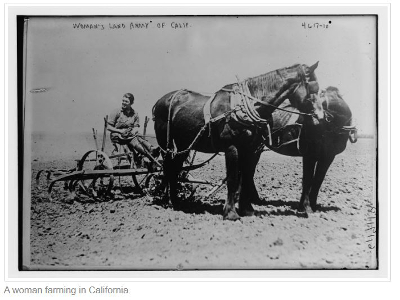
Women's Land Army, 1914-1919
The Women’s Land Army was a program in which some women’s universities trained women to work the land to meet the needs of the country. The Women’s Land Army of America existed in forty states and the District of Columbia. The government did not give the WLAA any federal funding—all funds came from private contributions. Women who joined the WLAA were known as “Farmerettes.”
The California Women’s Land Army in particular had extraordinary employment terms, including equal pay to what male farm laborers received, an eight-hour day, and overtime pay. In addition, women enjoyed comfortable living quarters and workers’ compensation. insurance, which were terms considered radical for male employees in the era.
Northern and Southern California farmers asked for WLA units to be based near their farms to meet the labor needs for their properties. “This woman’s land army, composed of able-bodied young women, selected just as the men are selected by the army, for their physical capacity, their good characters, their general deportment, and trained and disciplined even rather more strictly than the men... are acquitting themselves with amazing efficiency.” - Alma Whitaker, LA Times reporter
Questions
What other ways did women help the war effort?
What types of farming did the Women's Land Army help with?
What areas specifically did the California Women's Land Army work in?
Elaine F. Weiss, "Before Rosie the Riveter, Farmerettes Went to Work," Smithsonian Magazine (May 28, 2009)

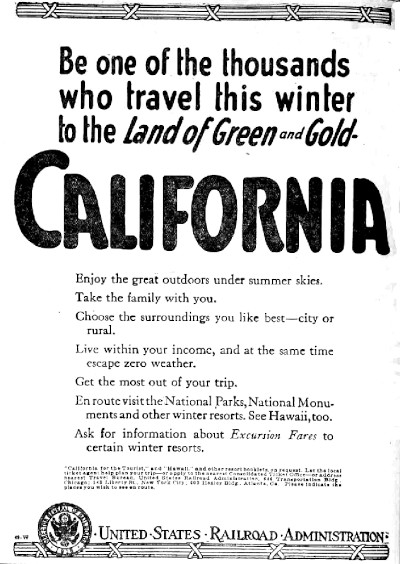
Nationalization of the Railroad Industry
Although the railroad had been economically successful and had helped transport agricultural commodities and other goods across the country for decades, by the early 20th century, the entire industry was struggling. Between increasing need for repairs and updates in railroad stations, tracks, and cars and the onset of the trucking industry that could transport the same things for lower rates and (in some cases) shorter time frames, railroad companies struggled to stay afloat. The onset of WWI created an opportunity, as the countries fighting in Europe purchased $3 billion in munitions and supplies from the U.S.
However, although the railroads could transport the goods across land, shipping facilities were ill-equipped to ship the heavy supplies across the ocean to Europe. As a result, railroad cars sat at shipping ports, most of which were on the East Coast, for long periods of time. This meant less available railroad cars to transport the usual freight traffic across the U.S. In combination with this decline in available cars, rising taxes, caps on shipping rates, increasing operational costs, and the lingering threat of railroad union strikes for better pay and shorter work days, the U.S. declaration of war in 1917 further impounded the railroads as soldiers needed to travel from home to training facilities and embarkation points.
Despite attempts to negate these issues, including the creation of the Railroads’ War Board, by December 1917 it was obvious that the situation was not sustainable. President Wilson issued a nationalization order in late December, and on December 28, 1917, the U.S. government officially took control over steam and electric-powered railroads as well as railroad-owned cars, elevators, warehouses, telephone and telegraph lines, stations, and associated properties. In total, the USRA (United States Railroad Administration) controlled 61,000 engines, 2.25 million freight cars, and 58,000 passenger cards. In addition, the USRA built over 100,000 new railroad cars and just under 2,000 new steam engines.
The USRA raised rates for passenger and freight traffic in 1918, and increased employee wages. In addition, the USRA ran advertisements encouraging U.S. citizens to travel via railroad in an effort to increase profits, including an ad specifically advertising travel to California that ran in 1919. The railroads would remain under USRA control until March 1920, at which time control was returned to the legal owners and operators of the railroad companies. The USRA’s efforts resulted in increased freight capacity, more freight cars running, and increased train speeds. In addition, the required amount of coal per 1,000 tons declined, meaning that the engines were more efficient overall.
Questions
What were the motivations behind nationalizing the railroads?
How did the USRA increase profits?
What technological advancements accompanied the USRA's control over the industry?
FreightWaves, "U.S. railroads were nationalized in World War I," published 2021


